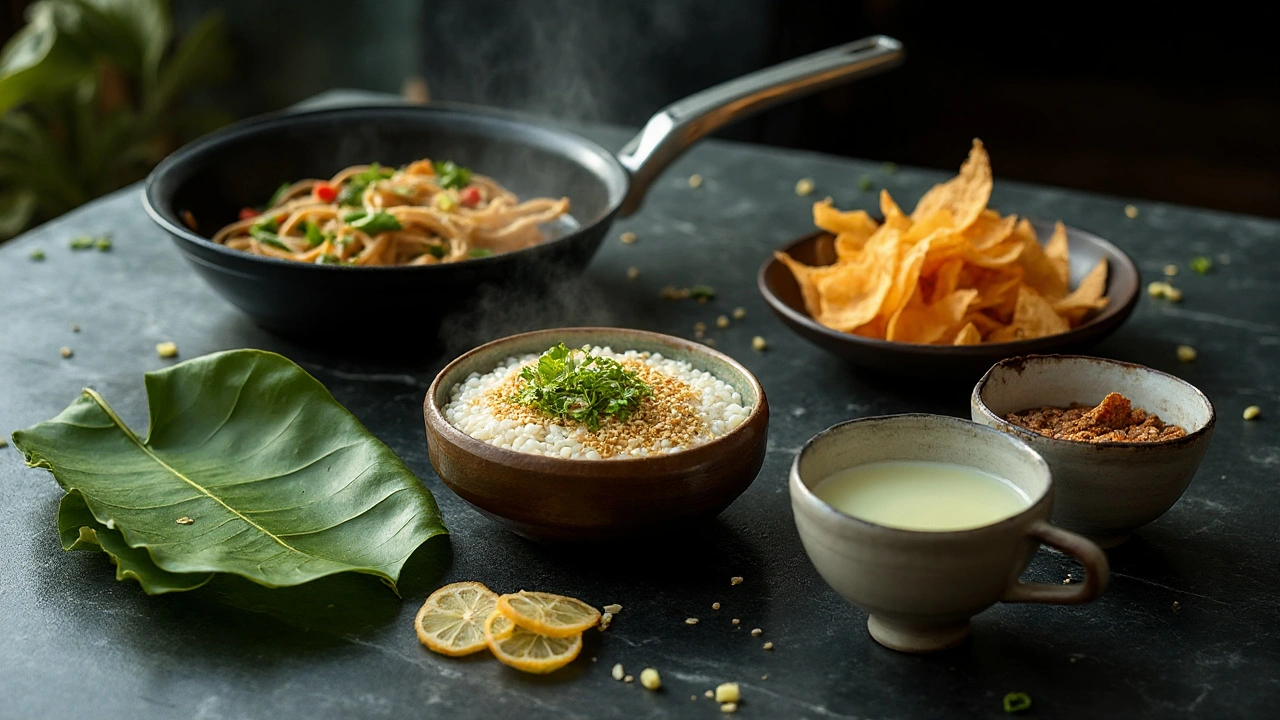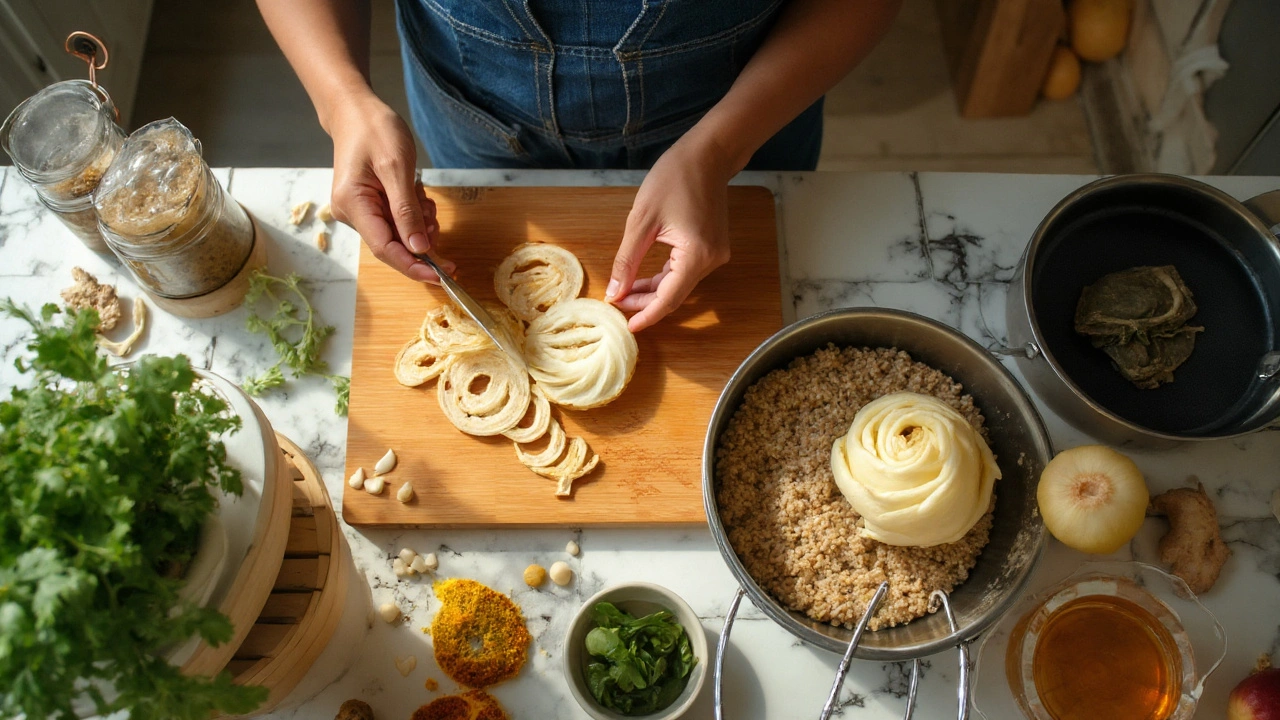You want a secret ingredient that actually changes your diet? Here’s the honest version: Kamala can deliver, but only if you pick the right “Kamala” and use it consistently. The word is confusing online, and some products under that name aren’t even meant for eating. The smart play is simple: use lotus-the edible plant often referred to as kamal/kamala in South Asia. Lotus root and seeds slot into everyday meals, boost fibre and satiety, and taste good enough to stick with. No magic, just a useful lever you can pull every single day.
- TL;DR
- “Kamala” you can eat = lotus (Nelumbo nucifera): root, seeds, leaf/tea. Avoid the dye/powder from Mallotus philippensis for food use.
- What you get: fibre for fullness, steady energy, potassium for blood pressure support, and versatile, easy-to-cook foods.
- Best picks: lotus root (stir-fries, soups), lotus seeds/makhana (crunchy, low-guilt snack), lotus leaf as tea or flavouring.
- Realistic results: better portion control and smoother blood sugar swings in weeks if you pair it with protein, veg, and movement.
- Safety: food forms are generally safe; skip concentrated “fat-burner” extracts; check meds if you manage blood sugar or blood pressure.
What “Kamala” Actually Means (and What to Avoid)
Here’s the curveball: “Kamala” isn’t a single product online. You’ll see different plants wearing that name. Only one makes sense for a diet: lotus (Nelumbo nucifera). In Hindi, “kamal/kamala” refers to lotus-the plant with edible root (rhizome), seeds, and leaves used across Asian cuisines.
Two things often get bundled under “Kamala”:
- Lotus (Nelumbo nucifera): edible root, seeds, leaves-safe as food, widely used in cooking and teas.
- Kamala tree powder (Mallotus philippensis): a red/orange dye historically used as a deworming agent. Not a kitchen ingredient. Avoid as a dietary add-in.
If your goal is safe, useful nutrition, stick with lotus foods. They’re easy to find in UK Asian supermarkets and larger grocers’ world-food aisles. You’ll often see “lotus root,” “lotus seeds,” or “makhana” (popped lotus seeds).
| Product sold as “Kamala” | What it is | Use in diet? | Notes |
|---|---|---|---|
| Lotus root (fresh/frozen) | Lotus rhizome | Yes | Crunchy, mildly sweet; great in stir-fries and soups. |
| Lotus seeds/makhana | Lotus seeds (dried/popped) | Yes | Light snack; easy way to curb cravings. |
| Lotus leaf | Lotus leaf (dried) | Yes, as tea or flavour | Herbal brew; subtle support for appetite routine. |
| Kamala tree powder | Mallotus philippensis | No | Dye/folk remedy; not a food staple-skip. |
Bottom line: if the label doesn’t clearly say lotus (root, seeds, or leaf), don’t buy it as a food.
Evidence-Backed Benefits You Can Actually Feel
Lotus won’t do the work for you. It does make the work easier. Here’s how.
- Fullness that lasts: Lotus root gives you roughly 4-5 g fibre per 100 g with only about 74 kcal (USDA FoodData Central). That’s serious chewing for not many calories-ideal if portion control is your struggle.
- Smoother energy: The carbs in lotus root come with fibre and resistant starch when cooked and cooled. That can help blunt big glucose spikes compared with white bread/rice meals of the same calories.
- Blood pressure support: Lotus root is naturally rich in potassium (about 550 mg per 100 g). More potassium and less sodium is a classic combo for better blood pressure control when your GP says “watch the salt.”
- Snack that doesn’t boomerang: Popped lotus seeds (makhana) are light yet satisfying. A 25-30 g portion often lands close to 100-120 kcal with 2-3 g protein, making it a smarter swap for crisps.
- Polyphenols without the lecture: Lotus leaves and seeds contain flavonoids and alkaloids studied for metabolic support. Reviews in journals covering traditional and functional foods have catalogued these compounds across lotus parts. It’s early-stage for disease claims-use it for everyday nutrition, not miracle fixes.
What does this add up to over 3-6 weeks? Less mindless snacking, easier meal spacing (you’re less ravenous), and better adherence to your plan. Those boring wins are the ones that move the needle.
Citations you can trust: For hard numbers on lotus root and seeds, check USDA FoodData Central. For plant compounds across lotus parts (root/seed/leaf), look at peer‑reviewed reviews in the Journal of Ethnopharmacology and similar phytochemistry journals that focus on Nelumbo nucifera. They summarise lab and animal data alongside culinary use in humans.

How to Use Kamala Today: Meals, Portions, and a 7‑Day Starter Plan
Here’s the practical part-no chef skills required.
Lotus root: fast prep, big payoff
- Buy it: Fresh (firm, light brown skin) or frozen slices. Fresh in UK Asian grocers often runs £4-£7/kg; frozen 500 g bags are commonly £2-£3.
- Prep it: Peel, slice 3-5 mm thick. Soak slices in water with a splash of vinegar or lemon to keep them crisp and pale.
- Cook it: Stir-fry 5-7 minutes (still crunchy), roast 20-25 minutes at 200°C with oil and spices, or simmer in soups 10-15 minutes.
- Portion guide: 100-150 g per meal is a solid start; pair with protein for balance.
Flavour ideas:
- 15‑minute stir-fry: Sesame oil, garlic, soy or tamari, sliced lotus root, spring onions, a handful of edamame. Finish with toasted sesame seeds.
- Tray roast: Lotus slices + carrots + chickpeas, olive oil, smoked paprika, cumin, salt. Roast till edges go golden.
- Comfort soup: Chicken or veg stock, ginger, lotus root, mushrooms, a dash of white pepper. Add tofu or shredded chicken for protein.
Lotus seeds/makhana: the craving fixer
- Buy it: Dried (for boiling) or popped (for snacking). In Bristol/UK, 100 g popped bags land around £2-£3 in Indian grocers.
- Snack it: Dry-roast popped seeds 2-3 minutes, toss with a teaspoon of ghee or olive oil, sprinkle chilli, salt, and a pinch of turmeric.
- Make it a meal: Stir into yoghurt with cinnamon, or add to a mixed-nut jar to dilute the calories of nuts without losing crunch.
- Portion guide: 25-30 g for snacks; up to 50 g if you’ve trained hard and need the carbs.
Lotus leaf: keep it simple
- Use it as tea: 1 teaspoon dried leaf per cup, steep 5-7 minutes. Taste is green and earthy; don’t expect a magic fat burner.
- How often: 1-2 cups a day max. If you manage blood sugar or blood pressure, check it against your readings.
7‑day starter plan (plug-and-play)
This isn’t a diet-just easy swaps so you feel the difference quickly.
- Mon: Lunch stir-fry with lotus root + edamame + spring onions; snack = 30 g popped lotus seeds.
- Tue: Roast chicken, tray of spiced lotus root and carrots; evening tea: lotus leaf.
- Wed: Brothy soup with sliced lotus, mushrooms, tofu; snack = Greek yoghurt + handful of popped lotus seeds.
- Thu: Lotus root and chickpea salad (olive oil, lemon, parsley); snack = 1 fruit + 20 g lotus seeds.
- Fri: Stir-fry lotus + prawns + pak choi; evening tea if you like it.
- Sat: Roast veg medley (lotus, cauliflower, onions) + grilled salmon; snack = 30 g popped seeds.
- Sun: Slow-cooker stew with lotus, beef shin, carrots; optional mug of lotus leaf tea after a long walk.
Hydrate, keep protein steady (1.2-1.6 g/kg bodyweight if you’re active), and keep your steps or training routine as normal. Watch how your “I need a snack” moments fade.
Buy Smart: Labels, Forms, and Red Flags
Quick shopping rules so you get the good stuff.
What to look for
- Clear naming: “Lotus root,” “Lotus seeds,” “Makhana,” or “Nelumbo nucifera.”
- Simple ingredient lists: For popped seeds, ideally just seeds, a little oil, and spices.
- Texture and smell: Fresh root should be firm, not mushy, with no sour smell. Frozen slices should be separate, not a solid icy block.
- Packaging: For seeds, pick airtight packs. Stale makhana tastes like cardboard.
UK availability (2025 snapshot)
- Asian supermarkets: Most stock fresh or frozen lotus root, dried lotus seeds, and popped makhana.
- Large grocers: Occasionally frozen lotus root; world-food aisles sometimes carry popped lotus seeds.
- Price ballpark: Root £4-£7/kg fresh; frozen slices £2-£3 per 500 g; popped seeds £2-£3 per 100 g; dried seeds vary by brand.
Red flags to avoid
- “Kamala powder” with reddish dye, sold for crafts or pets-this is the Kamala tree dye. Not food.
- Weight-loss capsules with lotus leaf plus stimulants-skip. You don’t need a blend with caffeine and yohimbine complications.
- Exaggerated claims (e.g., “melt fat in 7 days”). If it sounds like a late-night advert, move on.
How much is enough?
- Lotus root: 100-200 g per serving, 3-6 times a week depending on your carbs and training.
- Popped seeds: 25-30 g as a snack, once a day if it helps you ditch crisps or sweets.
- Lotus leaf tea: 1 cup/day, 2 max.
Combine with protein and colourful veg. That’s the difference between “tasty carb” and “balanced meal.”

Risks, Mini‑FAQ, and Troubleshooting
Food-grade lotus is safe for most people, but let’s keep it clean and sensible.
Safety notes
- Allergies: Rare, but if you react to aquatic plants or new seeds, try a small portion first.
- Blood sugar and blood pressure: Lotus foods are fine, but lotus leaf tea and concentrated extracts can nudge readings. If you take meds for these, track your numbers when you start.
- Pregnancy and breastfeeding: Stick to culinary amounts (root, seeds, food-level tea). Avoid concentrated extracts.
- Interactions: If you’re on diuretics or antihypertensives, watch potassium intake if you go heavy on lotus root plus other high‑potassium foods.
FAQ
Is lotus low-carb?
Not really. It’s moderate carb with good fibre. Think “better carb,” not “low carb.”
Can lotus help me lose weight?
It helps by making meals filling and snacks less chaotic. That makes calorie control easier. Pair it with protein and a step goal, and you’ll feel the shift.
Lotus vs sweet potato?
Sweet potato is softer and sweeter with more vitamin A. Lotus is crisper with higher potassium per 100 g and fewer calories per bite. Both can live in the same week.
What does lotus root taste like?
Clean, mildly sweet, and crunchy-somewhere between water chestnut and a crisp potato.
Do I need organic?
Buy what you can afford. Peel and rinse the root. For seeds, pick reputable brands with recent packing dates.
Can I eat lotus raw?
It’s usually cooked. Light cooking improves taste and digestibility. Quick stir-fry or blanching is ideal.
Is makhana really better than crisps?
It’s lighter per handful and easier to portion. Season it yourself to control salt and oil.
Troubleshooting and quick fixes
- Not feeling fuller? Increase your lotus root portion by 50 g and add 20-30 g extra protein (tofu, chicken, edamame) to that meal.
- Blood sugar spikes? Cool cooked lotus root and reheat-the chill step increases resistant starch slightly. Add vinegar or lemon, and anchor the meal with protein.
- Bloated after eating? Slice thinner and cook longer for better digestibility, and start with smaller portions to let your gut adjust to the fibre.
- Bored of the taste? Change formats: roast into chips, toss seeds in cocoa and cinnamon, or try miso‑glazed lotus rounds under the grill.
- Cravings still hit at 9 pm? Pre‑portion makhana in 30 g bags and keep a bottle of fizzy water cold. Rituals beat willpower.
Mini checklists
Shopping checklist:
- Label says lotus (root/seeds/leaf) or Nelumbo nucifera.
- Fresh root is firm; frozen slices are free‑flowing.
- Seeds are crisp, not stale; simple ingredients.
- Prices align with the ranges above-extreme bargains can mean old stock.
Cooking checklist:
- Peel and slice root evenly (3-5 mm).
- Short soak in lightly acidulated water to keep colour and snap.
- Pair with protein and veg; season generously.
- Batch cook on Sunday: roast tray + bag of popped seeds for the week.
Expectation checklist:
- Week 1-2: Easier snacking control, better meal satisfaction.
- Week 3-4: Steadier energy; clothes a touch looser if calories are in check.
- Ongoing: A flexible staple you actually enjoy-so you keep going.
Quick note on science vs hype: Reviews in the Journal of Ethnopharmacology and similar outlets catalogue many promising compounds in lotus parts, but most “fat loss” claims come from extracts and early-stage work. Your win comes from behaviour change powered by smart foods. Use lotus for that: it’s tasty, filling, and versatile-exactly what sticks.
How to get started today: pick one of the three-stir-fry lotus root for dinner, roast a tray for meal prep, or stock 5 snack bags of popped lotus seeds. Consistency beats novelty every time.
One last SEO-friendly nudge for clarity: if you searched for Kamala benefits, think “lotus you can cook,” not a mystery powder. Keep it real, keep it delicious, and let the small wins add up.




Comments
12 Comments
kevin tarp
I appreciate the thorough breakdown of the edible lotus varieties. The distinction between Nelumbo nucifera and Mallotus philippensis is crucial, especially for anyone new to the ingredient. Checking the label for “lotus root” or “makhana” will save you from buying the wrong powder. It’s also worth noting that the fiber content makes it a practical addition to meals without adding many calories.
ravi kumar
The article finally gives proper credit to the Indian origins of lotus-something the West often glosses over. Our markets have had lotus for decades, yet many still mistake it for a gimmick weight‑loss fad. Remember, the authentic “kamal” is a staple in our regional cuisines, not a trendy supplement. If you’re buying it abroad, demand the proper scientific name, otherwise you’re likely getting a cheap filler.
SandraAnn Clark
Sounds like a decent plan if you actually buy the right stuff.
Vaibhav Sai
Wow, this guide is a buffet of useful tips, and I love the practical tone! The step‑by‑step prep for lotus root is crystal clear, and the seasoning ideas practically dance on the page! Don’t forget to soak the slices in a splash of lemon juice-trust me, the crunch stays perfect! Also, the roasted lotus‑seed snack suggestion pairs beautifully with a pinch of turmeric, giving both flavor and a golden hue! Keep experimenting, and you’ll find your own favorite combos-happy cooking!
Lindy Swanson
Honestly, all that hype feels overpriced. Most supermarkets charge a premium for “exotic” lotus, and you can get the same nutrients from cheap local veggies. Save your money and stick to basics.
Amit Kumar
I get where you’re coming from, but let’s look at the bigger picture. Lotus root isn’t just a fancy garnish, it’s a nutrient-dense carb that can fit into almost any diet. Its 4‑5 g of fiber per 100 g helps you feel full longer, which can curb late‑night cravings. Pairing it with a protein source, like tofu or chicken, creates a balanced plate that stabilizes blood sugar. The potassium content supports healthy blood pressure, a bonus for anyone watching sodium intake.
The texture‑contrast it brings to stir‑fry or soup keeps meals interesting, so you’re less likely to get bored. I’ve tried the roasted lotus root with smoked paprika, and the caramelized edges were addictive 😋. Adding a drizzle of sesame oil and a sprinkle of toasted seeds gives healthy fats without excess calories. For snack time, popping makhana with a dash of turmeric and a pinch of sea salt makes a low‑calorie crunchy treat that satisfies salt cravings 🍿. You can even toss the popped seeds into Greek yogurt for extra protein and a pleasant crunch.
If you’re concerned about carbs, remember that the resistant starch formed after cooling the cooked root slows glucose absorption. A simple trick is to blanch the root, cool it in the fridge, then reheat it before serving. Consistency is key-make a weekly batch of roasted lotus and portion it into snack bags; this removes decision fatigue. Over time you’ll notice steadier energy levels, fewer sugar spikes, and a modest reduction in overall calorie intake. So, give it a solid try for at least three weeks, track your satiety, and you’ll see whether it truly supports your goals 🚀.
Crystal Heim
The so‑called “miracle” claim is overrated. Lotus is a food, not a magic bullet.
Sruthi V Nair
Food is a vessel for culture. When we honor its origins we nourish more than bodies. Simplicity often hides depth.
Mustapha Mustapha
Great rundown, everyone! If you’re new to lotus, start with a small batch of root and experiment with simple seasonings. Feel free to share your favorite prep methods in the comments so we can all learn together. Community support makes the journey easier.
Ben Muncie
Check the label, avoid the dye. Stick to edible lotus forms.
kevin tarp
I agree with the heritage points, but also watch the carbohydrate load. Lotus root still contains moderate carbs, so balance it with protein and veg. Moderation keeps the benefits without unintended spikes.
ravi kumar
Exactly, and Indian vendors know the best varieties-don’t trust imported “generic” packs. Our local markets offer fresher, cheaper roots that keep the tradition alive. Support them, and you’ll get authentic quality.
Write a comment